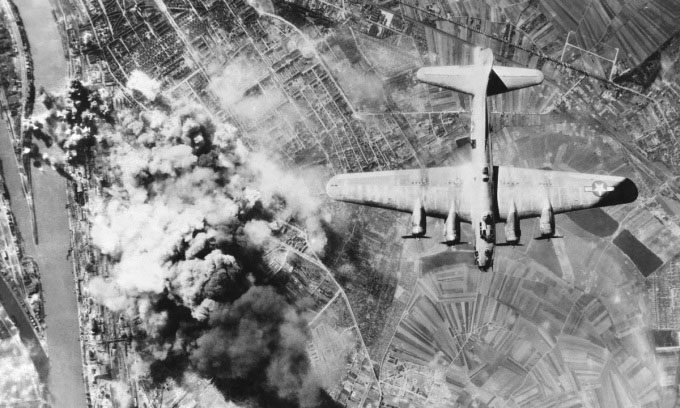Bombs containing Amatol compounds from decades ago are becoming increasingly dangerous as this substance becomes more sensitive to impacts.
The Earth is home to millions of tons of unexploded ordnance, particularly from the two World Wars that took place in the 20th century. While a significant amount remains buried and forgotten for decades, new research from a team of scientists at the University of Oslo and the University of Stavanger (Norway) indicates that many bombs contain a type of chemical that makes them increasingly prone to detonation over time, as reported by IFL Science on March 27. The new study was published in the journal Royal Society Open Science.

American Boeing B-17 Flying Fortress dropping bombs on the chemical and synthetic oil plant in Ludwigshafen, Germany during World War II. (Photo: Everett Collection)
This chemical is Amatol, a powerful explosive made from a mixture of TNT and ammonium nitrate, used in various types of ordnance manufactured for World War I and World War II, including aerial bombs, artillery shells, depth charges, and naval mines.
Other common explosives, such as pure trinitrotoluene (TNT) or Pentaerythritol tetranitrate (PETN), remain relatively stable over time and do not become more dangerous than they were initially. However, over time, Amatol seems to become more sensitive to impacts if stored under certain conditions.
In a series of new experiments, the Norwegian research team dropped weights onto five samples of Amatol explosives collected from battlefields. The results showed that these bombs were more sensitive to impacts than before and increasingly unstable. This change in properties is likely due to how Amatol interacts with other chemicals in the natural environment.
“The study reveals that the presence of moisture, along with other factors, can contribute to increasing the sensitivity of Amatol to impacts. Explosive mixtures containing ammonium nitrate can become sensitive when contaminated by small amounts of metals, or when in contact with metals. These contaminating metals can chemically react with ammonium nitrate, forming complex salts that increase the sensitivity of the mixture,” the research team explained.
Discovering unexploded bombs from World War II is not uncommon. Last month, a 500kg German bomb was found in the backyard of a house in Plymouth, England. Over 100 soldiers and bomb disposal experts were dispatched to handle it, while 10,000 nearby residents had to evacuate. Fortunately, the bomb was safely dealt with without any casualties. However, in 2008, 17 people at a construction site in the town of Hattingen, Germany, were injured when an excavator struck a 250kg World War II bomb, causing it to explode.
The new research indicates that incidents involving unexploded bombs could become increasingly serious. The research team also emphasized that those responsible for handling unexploded ordnance need to be informed about the increasing sensitivity of Amatol over time.


















































